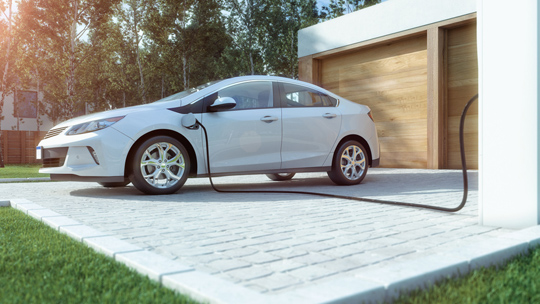Power from next door’s garden
Freiburg, Dec 12, 2018
Oxygen Technologies is aiming to prepare the energy market for the future: The start-up from Freiburg’s Fraunhofer Institute for Solar Energy Systems ISE and the University of Freiburg has produced a program which can regulate the optimal flow of power through the electricity grid. That electricity can come from thousands of small producers. Power companies can take the surplus electricity, collect it into one virtual power plant, and sell it.

Small producers are getting ready: Starting in 2021, excess power from private eco-plants will go onto the free market. Photo: gopper0815/Fotolia
“We have come up with a kind of Airbnb for energy,” says Gregor Rohbogner, Oxygen Technologies’ CEO. Starting in 2021, excess power from private eco-plants will go onto the free market. “With our technology, one neighbor can sell the excess produced by her solar panels straight to her next-door neighbor with an electric car,” says Rohbogner. By the same token, big energy providers can pool all the small amounts of excess electricity and sell them on for a small fee. But kilowatt hours are not like apartments rented out via Airbnb. The Oxygen Technologies software has to meet a different set of requirements. But the idea has some fans - energy providers Schönau EWS and EGT from Triberg bought into the start-up in April 2018.
Rohbogner wants to prepare the electricity market for digitization and decentralized production. “It will completely change the market structure, just as online shopping utterly changed retail sales.” The start-up’s core model consists of a virtual digital power station for energy providers. “In the long term, they will have to replace their classic energy business with digital energy services.” Model two is oriented towards the individual - it is the “Airbnb” for prosumers. The expression is a portmanteau of “produce” and “consume.” Prosumers make something and can either use it themselves or sell it to others.
Oxygen Technologies wants proper exploitation of the German eco-electricity harvest. In 2016, 42 percent of it was produced by farmers and other individuals - with their approximately 1.5 million wind-, water-, biogas- and solar-powered plants. German law guarantees these producers that their excess electricity will be put onto the grid at fixed prices until 2020. Then the first plants will no longer be subsidized. “From then on, prosumers will have to either use the electricity themselves or sell it themselves,” Rohbogner explains. Under the current system, the utilization chain between producers and users has too many middlemen taking their cut along the way. The main barrier to a rapid introduction of an Airbnb for electricity is the body of law regulating the power industry. Despite this, interested prosumers and owners of solar power systems can take part in the first German project region for decentralized electricity trading, run by EWS Schönau.
Eyes open on the grid
There is a second problem. Excess electricity is dangerous - there can only be as much power in the grid as is being consumed at any given time. “That’s a physical necessity” Rohbogner explains. Energy providers currently estimate how much electricity their customers will draw out of the grid in the next 24 hours. Then they feed that amount into the grid operators’ network. That works because a few big power stations deliver most of the electricity. In the range of household use - below the high tension grid - the grid operators know far too little about what is happening on the energy highways, Rohbogner says: “They are flying blind.” When it comes to the environmentally-friendly solar power, millions of widely-distributed small producers make the situation even more complex.

Regulating the optimal flow in real time: If there is too little electricity in the grid, the software tells the charging station to go slow. Photo: Herr Loeffler/Fotolia
Energy providers have to digitize
There is a solution: a little computer called the energy concierge, or e-concierge for short, made by Oxygen Technologies. “It has to go into every plant which can produce electricity, and into all the consumers’ connections,” Rohbogner says. If there is too little electricity in the grid, the e-concierge tells the electric car charging point: “Charge a bit slower!” If there’s a lot of electricity sloshing around, small solar plants will be told to cut back the amount they are putting into the grid. “Every minute, every single machine reports how much it is using and what it can produce right now,” Rohbogner says. “The hardware is provided by partners. We deliver the software.” With this clever algorithm, the e-concierge can regulate all the regulatable devices in real time - so that there is always just the right amount of electricity running through the grid.
But the e-concierge does need one key thing: digital electricity meters on all devices. The process of installing such meters has already begun. With their digital data, the e-concierge will not only be able to adjust supply and demand on the grid. Small producers will be able to use the clever counter to register their excess production on a trading platform. The neighbor with the electric car can buy energy there whenever he needs it or whenever it is cheap. “All the participants send each other alternating amounts and offers. Our electricity trading algorythm calculates who can offer or consume electricity when, and on what conditions.” The price at any given moment will depend on supply and demand.
Virtual power plants with their own logo
Via the e-concierge energy providers will, for the first time, be able to virtually pool the excess from thousands of small producers on a central server. The energy providers and small producers will sign contracts for this. “We can’t run your plant and receive only a few cents per kilowatt hour that we sell,” says Rohbogner, giving an example. Energy providers will instead put together a virtual power station made up of all the small producers’ contributions.
“I headed a team at ISE which worked on decentralized management systems,” Rohbogner says. He and his ISE colleagues realized that the field was very interesting for the coming energy market. The four of them founded Oxygen Technologies. The university’s start-ups office helped them to submit a successful application for an EXIST research transfer grant from the German government. Now EWS and EGT are letting new expertise and infrastructure into the new business. “Everything has gone well so far. The technology is ready and we have customers,” says Rohbogner. The high demand means Oxygen Technologies has had to beef up its team. It currently has about 20 employees; by the end of 2019 it will likely be 35.
Jürgen Schickinger

